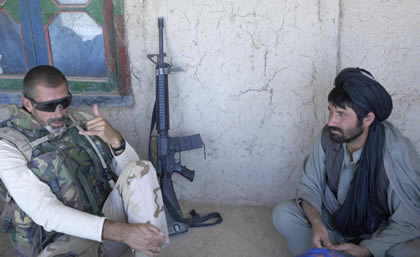
Can ISAF forces really ‘win the hearts and minds of the Afghans’? The Dutch contingent controlling parts of Uruzgan in central Afghanistan are demonstrating how such a task can be achieved. While southern Afghanistan insurgency rises to new heights, in Uruzgan the number of attacks has been decreasing steadily in recent years, while Taliban controlled areas are shrinking. The Dutch forces claim credit for this progress, the result of close cooperation and trust building process with the local populations. Early in their deployment, the Dutch decided to position their forces in the towns and villages where the majority of Uruzgan’s population lives. This strategy has deliberately left the high desert area and remote villages for the Taliban.

By contrast the British forces in neighboring Helmand decided to spread across less populated areas where they are occupied mostly with self defense and less capable to interact and support the population. The Dutch were less obsessed with finding the Taliban. While isolating them from stronger support bases in the villages and towns the Taliban could roam the high desert and isolated villages uncontested, using the area as a rest area and staging ground to hit British forces in neighboring Helmand, leaving the Dutch forces safe in their area. The casualties suffered by the two forces are striking – With the British forces taking 160, compared with 18 Dutch casualties. The Dutch military claims its containment strategy is working – while the British were struggling to hold their ground, the area under Dutch control is growing and the Dutch commander, General Tom Middendorp says he is not handing territory to his enemy. Claiming the Taliban’s is pushed back to the higher and rougher terrain.
“In the beginning, two years ago they covered the whole province. Now they cover only the more outer parts. There they have less chance of surviving.” Said Middendorp “you have to make choices, you can’t cover anywhere. You have to start on the key areas, and the key areas are the populated areas.” The General expects the Afghan army and the police to gradually take over control, and improve security and quality of life.
While the Dutch strategy is apparently working, terrain, and Afghan internal aspects are also working in their favor. The mountainous area of Uruzgan enables the Ducch military to effectively dominate the few roads in the area, limiting enemy movement between the major population centers. Furthermore, the area’s population is divided between valley and mountain tribes which are also divided among them, leaving Taliban no clear dominance among the mountain tribes. But most important, the area is considered less strategic to the Taliban, since opium farming is not as dominant here as in Helmand, and Kandahar.
Nevertheless, the Dutch forces can take the credit for keeping their area quiet and under control. However, the Dutch success may be short lived since Dutch politicians want their forces to pull out in 2010, and when they go away, Taliban will definitely return. In fact, they never went away, they were out of reach.
The Afghans have made their choice and ISAF won’t like it – many would prefer to be ruled by the Moslem Taliban rather than to be caught in the crossfire between foreign troops, Taliban and the Afghan security forces. Whether the new American counterinsurgency doctrine that puts protecting civilians above killing Taliban convince the Afghan population to switch sides remain unanswered. They need time and patience to be convinced, and time, we know, is a rare commodity in western politics.
- Part I: New Surge Reflects a Fresh Strategy for Afghanistan
- Part II: Changing Strategy for Afghanistan
- Part III: Winning Afghanistan – A Realistic Objective?
- Part IV: Psychological Campaign to Win Civilian Support in Afghanistan
- Part V: British Troops Seize Control of Helmands’ Lifeline the Shamalan Irrigation Canal

















